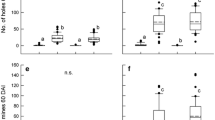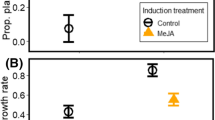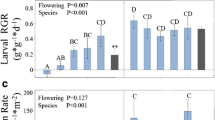Abstract
Plants are often attacked by pathogens and insects. Their combined impact on plant performance and fitness depends on complicated three-way interactions and the plant’s ability to compensate for resource losses. Here, we evaluate the response of Barbarea vulgaris, a wild crucifer, to combined attack by an oomycete Albugo sp., a plant pathogen causing white rust, and a flea beetle, Phyllotreta nemorum. Plants from two B. vulgaris types that differ in resistance to P. nemorum were exposed to Albugo and P. nemorum alone and in combination and then monitored for pathogen infection, herbivore damage, defence compounds, nutritional quality, biomass and seed production. Albugo developed infections in the insect-resistant plants, whereas insect-susceptible plants were scarcely infected. Concentrations of Albugo DNA were higher in plants also exposed to herbivory; similarly, flea beetle larvae caused more damage on Albugo-infected plants. Concentrations of saponins and glucosinolates strongly increased when the plants were exposed to P. nemorum and when the insect-susceptible plants were exposed to Albugo, and some of these compounds increased even more in the combined treatment. The biomass of young insect-susceptible plants was lower following exposure to flea beetles, and the number of leaves of both plant types was negatively affected by combined exposure. After flowering, however, adult plants produced similar numbers of viable seeds, irrespective of treatment. Our findings support the concept that pathogens and herbivores can affect each other’s performance on a host plant and that the plant reacts by inducing specific and general defences. However, plants may be able to compensate for biomass loss from single and combined attacks over time.




Similar content being viewed by others
References
Agerbirk N, Olsen CE (2011) Isoferuloyl derivatives of five seed glucosinolates in the crucifer genus Barbarea. Phytochemistry 72:610–623
Agerbirk N, Olsen CE, Nielsen JK (2001) Seasonal variation in leaf glucosinolates and insect resistance in two types of Barbarea vulgaris ssp arcuata. Phytochemistry 58:91–100
Agerbirk N, Olsen CE, Bibby BM, Frandsen HO, Brown LD, Nielsen JK, Renwick JAA (2003a) A saponin correlated with variable resistance of Barbarea vulgaris to the diamondback moth Plutella xylostella. J Chem Ecol 29:1417–1433
Agerbirk N, Ørgaard M, Nielsen JK (2003b) Glucosinolates, flea beetle resistance, and leaf pubescence as taxonomic characters in the genus Barbarea (Brassicaceae). Phytochemistry 63:69–80
Agrawal AA (2000) Benefits and costs of induced plant defense for Lepidium virginicum (Brassicaceae). Ecology 81:1804–1813
Augustin JM, Kuzina V, Andersen SB, Bak S (2011) Molecular activities, biosynthesis and evolution of triterpenoid saponins. Phytochemistry 72:435–457
Augustin JM, Drok S, Shinoda T, Sanmiya K, Nielsen JK, Khakimov B, Olsen CE, Hansen EH, Kuzina V, Ekstrøm CT, Hauser T, Bak S (2012) UDP-glycosyltransferases from the UGT73C subfamily in Barbarea vulgaris catalyze sapogenin 3-O-glucosylation in saponin-mediated insect resistance. Plant Physiol 160:1881–1895
Bekaert M, Edger PP, Hudson CM, Pires JC, Conant GC (2012) Metabolic and evolutionary costs of herbivory defense: systems biology of glucosinolate synthesis. New Phytol 196:596–605
Cooper AJ, Latunde-Dada AO, Woods-Tor A, Lynn J, Lucas JA, Crute IR, Holub EB (2008) Basic compatibility of Albugo candida in Arabidopsis thaliana and Brassica juncea causes broad-spectrum suppression of innate immunity. Mol Plant Microbe Interact 21:745–756
Dangl J, Holub E, Debener T, Lehnackers H, Ritter C, Crute I, Koncz C, Chua N, Schell J (1992) Genetic definition of loci involved in Arabidopsis–pathogen interactions. In: Koncz C, Chua NH, Schell J (eds) Methods in Arabidopsis research. World Scientific Publishing Co, Singapore, pp 393–418
de Jong PW, de Vos H, Nielsen JK (2001) Demic structure and its relation with the distribution of an adaptive trait in Danish flea beetles. Mol Ecol 10:1323–1332
Fahey JW, Zalcmann AT, Talalay P (2001) The chemical diversity and distribution of glucosinolates and isothiocyanates among plants. Phytochemistry 56:5–51
Fornoni J (2011) Ecological and evolutionary implications of plant tolerance to herbivory. Funct Ecol 25:399–407
Fournier V, Rosenheim JA, Brodeur J, Diez JM, Johnson MW (2006) Multiple plant exploiters on a shared host: testing for nonadditive effects on plant performance. Ecol Appl 16:2382–2398
Gershenzon J (1994) Metabolic costs of terpenoid accumulation in higher-plants. J Chem Ecol 20:1281–1328
Gomez S, Ferrieri RA, Schueller M, Orians CM (2010) Methyl jasmonate elicits rapid changes in carbon and nitrogen dynamics in tomato. New Phytol 188:835–844
Griffiths DW, Deighton N, Birch ANE, Patrian B, Baur R, Stadler E (2001) Identification of glucosinolates on the leaf surface of plants from the Cruciferae and other closely related species. Phytochemistry 57:693–700
Halkier BA, Gershenzon J (2006) Biology and biochemistry of glucosinolates. Annu Rev Plant Biol 57:303–333
Hasenbank M, Brandon A, Hartley S (2011) White butterfly (Pieris rapae) and the white rust Albugo candida on Cook’s scurvy grass (Lepidium oleraceum). N Z J Ecol 35:69–75
Hatcher PE (1995) Three-way interactions between plant-pathogenic fungi, herbivorous insects and their host plants. Biol Rev 70:639–694
Hatcher PE, Paul ND (2000) On integrating molecular and ecological studies of plant resistance: variety of mechanisms and breadth of antagonists. J Ecol 88:702–706
Hauser T, Toneatto F, Nielsen J (2012) Genetic and geographic structure of an insect resistant and a susceptible type of Barbarea vulgaris in western Europe. Evol Ecol 26:611–624
Hauser TP, Christensen S, Heimes C, Kiær LP (2013) Combined effects of arthropod herbivores and phytopathogens on plant performance. Funct Ecol 27:623–632
Heil M, Baldwin IT (2002) Fitness costs of induced resistance: emerging experimental support for a slippery concept. Trends Plant Sci 7:61–67
Hopkins RJ, van Dam NM, van Loon JJA (2009) Role of glucosinolates in insect-plant relationships and multitrophic interactions. Annu Rev Entomol 54:57–83
Jacobson DJ, LeFebvre SH, Ojerio RS, Berwald N, Heikkinen E (1998) Persistent, systemic, asymptomatic infections of Albugo candida, an oomycete parasite, detected in three wild crucifer species. Can J Bot–Rev Can De Bot 76:739–750
Koornneef A, Pieterse CMJ (2008) Cross talk in defense signaling. Plant Physiol 146:839–844
Kuzina V, Ekstrom CT, Andersen SB, Nielsen JK, Olsen CE, Bak S (2009) Identification of defense compounds in Barbarea vulgaris against the herbivore Phyllotreta nemorum by an ecometabolomic approach. Plant Physiol 151:1977–1990
Kuzina V, Nielsen JK, Augustin JM, Torp AM, Bak S, Andersen SB (2011) Barbarea vulgaris linkage map and quantitative trait loci for saponins, glucosinolates, hairiness and resistance to the herbivore Phyllotreta nemorum. Phytochemistry 72:188–198
Martinkova J, Klimesova J, Mihulka S (2008) Compensation of seed production after severe injury in the short-lived herb Barbarea vulgaris. Basic Appl Ecol 9:44–54
Massad TJ, Dyer LA, Vega CG (2012) Costs of defense and a test of the carbon-nutrient balance and growth-differentiation balance hypotheses for two co-occurring classes of plant defense. PLoS ONE 7:e47554
Mathur P, Sharma E, Singh SD, Bhatnagar AK, Singh VP, Kapoor R (2013) Effect of elevated CO2 on infection of three foliar diseases in oilseed Brassica juncea. J Plant Pathol 95:135–144
Morris WF, Hufbauer RA, Agrawal AA, Bever JD, Borowicz VA, Gilbert GS, Maron JL, Mitchell CE, Parker IM, Power AG, Torchin ME, Vazquez DP (2007) Direct and interactive effects of enemies and mutualists on plant performance: a meta-analysis. Ecology 88:1021–1029
Mouttet R, Bearez P, Thomas C, Desneux N (2011) Phytophagous arthropods and a pathogen sharing a host plant: evidence for indirect plant-mediated interactions. PLoS ONE 6:e18840
Nielsen JK (1997) Variation in defences of the plant Barbarea vulgaris and in counter adaptations by the flea beetle Phyllotreta nemorum. Entomol Exp Appl 82:25–35
Nielsen JK (1999) Specificity of a Y-linked gene in the flea beetle Phyllotreta nemorum for defences in Barbarea vulgaris. Entomol Exp Appl 91:359–368
Nielsen J, Nagao T, Okabe H, Shinoda T (2010) Resistance in the plant, Barbarea vulgaris, and counter-adaptations in flea beetles mediated by saponins. J Chem Ecol 36:277–285
Nunez-Farfan J, Fornoni J, Valverde PL (2007) The evolution of resistance and tolerance to herbivores. Annu Rev Ecol Evol Syst 38:541–566
Osbourn A (1996) Saponins and plant defence—a soap story. Trends Plant Sci 1:4–9
Paul ND, Hatcher PE, Taylor JE (2000) Coping with multiple enemies: an integration of molecular and ecological perspectives. Trends Plant Sci 5:220–225
Pieterse CMJ, Dicke M (2007) Plant interactions with microbes and insects: from molecular mechanisms to ecology. Trends Plant Sci 12:564–569
Ploch S, Thines M (2011) Obligate biotrophic pathogens of the genus Albugo are widespread as asymptomatic endophytes in natural populations of Brassicaceae. Mol Ecol 20:3692–3699
Renwick JAA (2002) The chemical world of crucivores: lures, treats and traps. Entomol Exp Appl 104:35–42
Rostas M, Hilker M (2002) Asymmetric plant-mediated cross-effects between a herbivorous insect and a phytopathogenic fungus. Agric For Entomol 4:223–231
Schjoerring JK, Kyllingsbaek A, Mortensen JV, ByskovNielsen S (1993) Field investigations of ammonia exchange between barley plants and the atmosphere. 1. Concentration profiles and flux densities of ammonia. Plant Cell Environ 16:161–167
Schlaeppi K, Abou-Mansour E, Buchala A, Mauch F (2010) Disease resistance of Arabidopsis to Phytophthora brassicae is established by the sequential action of indole glucosinolates and camalexin. Plant J 62:840–851
Shinoda T, Nagao T, Nakayama M, Serizawa H, Koshioka M, Okabe H, Kawai A (2002) Identification of a triterpenoid saponin from a crucifer, Barbarea vulgaris, as a feeding deterrent to the diamondback moth, Plutella xylostella. J Chem Ecol 28:587–599
Siemens DH, Garner SH, Mitchell-Olds T, Callaway RM (2002) Cost of defense in the context of plant competition: Brassica rapa may grow and defend. Ecology 83:505–517
Stout MJ, Thaler JS, Thomma BPHJ (2006) Plant-mediated interactions between pathogenic microorganisms and herbivorous arthropods. Annu Rev Entomol 51:663–689
Szakiel A, Paczkowski C, Henry M (2011) Influence of environmental biotic factors on the content of saponins in plants. Phytochem Rev 10:493–502
Tack AJM, Dicke M (2013) Plant pathogens structure arthropod communities across multiple spatial and temporal scales. Funct Ecol 27:633–645
Thaler JS, Humphrey PT, Whiteman NK (2012) Evolution of jasmonate and salicylate signal crosstalk. Trends Plant Sci 17:260–270
Toneatto F (2009) Genetics and distribution of insect resistance polymorphism in Barbarea vulgaris. PhD thesis. University of Copenhagen, Frederiksberg
Toneatto F, Nielsen JK, Ørgaard M, Hauser TP (2010) Genetic and sexual separation between insect resistant and susceptible Barbarea vulgaris plants in Denmark. Mol Ecol 19:3456–3465
Toneatto F, Hauser TP, Nielsen JK, Ørgaard M (2012) Genetic diversity and similarity in the Barbarea vulgaris complex (Brassicaceae). Nord J Bot 30:506–512
Traw MB (2002) Is induction response negatively correlated with constitutive resistance in black mustard? Evolution 56:2196–2205
Traw MB, Dawson TE (2002) Reduced performance of two specialist herbivores (Lepidoptera: Pieridae, Coleoptera: Chrysomelidae) on new leaves of damaged black mustard plants. Environ Entomol 31:714–722
van Leur H, Raaijmakers CE, van Dam NM (2006) A heritable glucosinolate polymorphism within natural populations of Barbarea vulgaris. Phytochemistry 67:1214–1223
van Leur H, Raaijmakers CE, van Dam NM (2008) Reciprocal interactions between the cabbage root fly (Delia radicum) and two glucosinolate phenotypes of Barbarea vulgaris. Entomol Exp Appl 128:312–322
van Molken T, de Caluwe H, Hordijk CA, Leon-Reyes A, Snoeren TAL, van Dam NM, Stuefer JF (2012) Virus infection decreases the attractiveness of white clover plants for a non-vectoring herbivore. Oecologia 170:433–444
van Mölken T, Heimes C, Hauser TP, Sundelin T (2014) Phylogeny of an Albugo sp. infecting Barbarea vulgaris in Denmark and its frequency of symptom development in natural populations of two evolutionary divergent plant types. Fungal Biol. Available at: http://dx.doi.org/10.1016/j.funbio.2014.01.008
Walters D, Heil M (2007) Costs and trade-offs associated with induced resistance. Physiol Mol Plant Pathol 71:3–17
Wang Y, Bouwmeester K, Van de Mortel JE, Shan WX, Govers F (2013) A novel Arabidopsis-oomycete pathosystem: differential interactions with Phytophthora capsici reveal a role for camalexin, indole glucosinolates and salicylic acid in defence. Plant Cell Environ 36:1192–1203
Zust T, Joseph B, Shimizu KK, Kliebenstein DJ, Turnbull LA (2011) Using knockout mutants to reveal the growth costs of defensive traits. Proc R Soc B Biol Sci 278:2598–2603
Acknowledgments
We are grateful to the Barbarea group at University of Copenhagen for fruitful discussions and support. We thank L. Munk and E. B. Holub for advice on Albugo inoculation. M-B. Sauer, C. Heimes, S. Christensen and H. Olsen helped with the practical work, J. K. Schjoerring and A.H. Ivø with the nitrogen analyses, and R. A. de Graaf with the glucosinolate analyses. This work was funded by the Danish Agency for Science, Technology and Innovation (grant no. 274-08-0462); the authors declare that they have no conflict of interest with this Agency. All experiments comply with current Danish laws.
Author information
Authors and Affiliations
Corresponding author
Additional information
Communicated by Corné Pieterse.
Electronic supplementary material
Below is the link to the electronic supplementary material.
Rights and permissions
About this article
Cite this article
van Mölken, T., Kuzina, V., Munk, K.R. et al. Consequences of combined herbivore feeding and pathogen infection for fitness of Barbarea vulgaris plants. Oecologia 175, 589–600 (2014). https://doi.org/10.1007/s00442-014-2928-4
Received:
Accepted:
Published:
Issue Date:
DOI: https://doi.org/10.1007/s00442-014-2928-4




